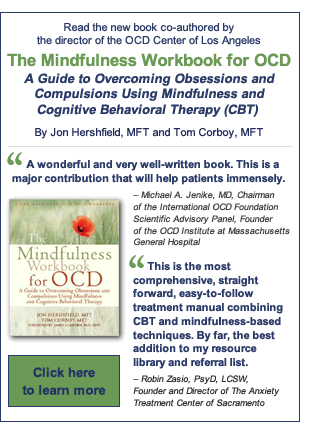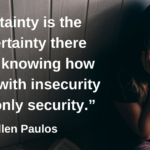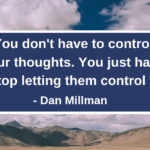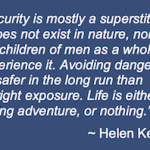Follow @ocdla
Cognitive Behavioral Therapy (CBT) is the gold standard for the treatment of OCD and related anxiety based conditions. But some simple mistakes can interfere with treatment. Kimberley Quinlan, MFT, of the OCD Center of Los Angeles discusses five common roadblocks to effective treatment for OCD and anxiety.

Research has consistently found that the most effective treatment for Obsessive Compulsive Disorder (OCD) and most other anxiety disorders is Cognitive Behavioral Therapy (CBT). The cognitive component of CBT involves investigating and challenging the individual’s irrational thoughts related to their fears. These thoughts are described as “cognitive distortions”, and the process of challenging them is known as “cognitive restructuring”. This process takes place during therapy sessions, and is also practiced by the client between sessions throughout the course of treatment.
The behavioral component of CBT is more time intensive, and requires the client to be gradually, purposefully and systematically exposed to the very thoughts and situations which generate their discomfort, and to do so without responding with either compulsive or avoidant behaviors. This process is known as Exposure and Response Prevention (ERP).
At the OCD Center of Los Angeles, in addition to traditional CBT as described above, we also focus a significant amount of our treatment on what is known as Mindfulness Based Cognitive Behavioral Therapy (MBCBT). Mindfulness Based CBT is not a substitution for cognitive restructuring and ERP, but rather an addition to them. MBCBT focuses on helping clients learn to accept the existence of their unwanted thoughts, feelings, sensations, and urges, and to elect not to respond to them in a compulsive or avoidant manner. This requires the client to choose a different way of thinking about their obsessions and other anxiety symptoms.
In the course of treatment with CBT and MBCBT, the therapist helps the client to challenge the accuracy and legitimacy of the his/her thoughts (obsessions), while at the same time accepting the ongoing existence of those thoughts, as well as the existence of other unwanted experiences such as uncomfortable feelings, sensations, and urges. Over time, clients learn that they are able to tolerate these experiences without doing either compulsive or avoidant behaviors.
Unlike more traditional talk therapy, CBT is a dynamic and directed style of treatment. But there are numerous pitfalls along the way. A seasoned Cognitive Behavioral therapist knows to keep a watchful eye out for certain roadblocks that are likely to hinder a client’s therapeutic progress. Given the fact that obsessions and compulsions occur mostly outside of the therapist’s office, and that the client is responsible for completing a good deal of homework between sessions, the client has frequent opportunities to get sidetracked. Here are five common roadblocks clients need to be aware of when entering into treatment for OCD and anxiety using CBT and MBCBT.
Not doing your homework
One of the biggest barriers to successful treatment is when the client believes that just coming to therapy will make them better. Yes, consistently attending therapy is a cornerstone to improving your symptoms, but it is not all that is required. There are 168 hours in a week, and if you are attending therapy 1-2 hours per week, but not doing your CBT homework, your progress will be extremely slow. When do you do most of your compulsions? At home? At work? At social events? You will need to be committed to practicing mindfulness, and to exposing yourself to your specific obsessions and fears, and to doing both without responding to your discomfort with compulsions or avoidant behaviors.
Performing other compulsions while doing exposure therapy
When human beings experience anxiety, we will often do just about anything to make it go away. During treatment, we help our clients learn to identify the compulsive and avoidant behaviors they are using in an effort to rid themselves of their anxiety. We then help them gradually expose themselves to their fear without using these behaviors.
One common treatment mistake is to replace one compulsive behavior with another. For example, “Annie” always flicks the lights seven times when entering or exiting a room. Our goal is to get Annie to walk through the door without flicking the light switches at all (unless of course she legitimately needs to turn the lights on or off, in which case one flick of the lights is appropriate). If Annie goes through the door without flicking the switches, but then says certain prayers while going through the door, or mentally imagines herself flicking the switches, then she is still doing compulsions. Likewise, if she simply avoids that room in order to avoid the light switches, she is doing an avoidant compulsion. Replacing one compulsion with another will dramatically slow down her treatment.
Another example would be “John”, who always feels the need to mentally review his day in order to get a sense of certainty that he did not harm anyone. John’s exposure would be to purposely have a thought about harming someone, and to then not do a mental review. The goal here is for John to accept the discomfort that this thought causes, while making no effort to mitigate that discomfort. If John performs his exposure, but then seeks reassurance by asking his girlfriend to confirm that he hasn’t actually hurt anyone, he is still being compulsive. And if he also chooses to check his hands for blood or to inspect the silverware drawer for evidence of missing knives, these behaviors are also compulsions, and they will counteract his ERP efforts. These common mistakes do not allow John to be fully exposed to his fear, and in turn, his treatment progress will suffer.
Expecting your therapist to know your OCD and anxiety symptoms
After reading the above points, you may notice that there are many types of compulsions. It is important to be aware of all of them in order to make sure you are completing your exposure assignments correctly and thoroughly. There are four primary types of compulsions.
- overt compulsions
- avoidant compulsions
- reassurance seeking compulsions
- mental compulsions
Overt compulsions are actual physical behaviors that one does in an effort to reduce anxiety and obsessions. Avoidance of a specific feared object, situation, or thought is just another compulsive way of trying to reduce anxiety or obsessions. Reassurance seeking is a common compulsion that is often overlooked during treatment, and involves finding certainty from those around you (often family members or partners) or via other sources such as the internet or newspapers. Last of all, there are mental compulsions. These are often difficult  to identify as they are going on only in the mind of the sufferer (for example, compulsive prayer, counting rituals, mental review of situations, etc.). Mental compulsions can easily be overlooked, especially if your therapist is not trained to fully understand and treat OCD. The key is for clients to be aware of all of these different types of symptoms, and to be sure to discuss any and all symptoms with their therapist (including new symptoms that may arise during the course of treatment). If you fail to inform your therapist of all of your symptoms, even those which you find terribly anxiety provoking or embarrassing, there is no way that your therapist can help you fully face your fears.
to identify as they are going on only in the mind of the sufferer (for example, compulsive prayer, counting rituals, mental review of situations, etc.). Mental compulsions can easily be overlooked, especially if your therapist is not trained to fully understand and treat OCD. The key is for clients to be aware of all of these different types of symptoms, and to be sure to discuss any and all symptoms with their therapist (including new symptoms that may arise during the course of treatment). If you fail to inform your therapist of all of your symptoms, even those which you find terribly anxiety provoking or embarrassing, there is no way that your therapist can help you fully face your fears.
Constantly analyzing your symptoms
We humans are extremely good at fooling ourselves into believing “If I just figure this out, I will not have anxiety about it”. But if you are invested in trying to understand why you have OCD or other anxiety symptoms, you are almost guaranteed to feel even more confused and anxious.
Unfortunately, it is common practice in traditional talk therapy to analyze the client’s feelings in an effort to get the “root” of the issue. While this may seem like a good idea, it is the exact wrong thing to do for someone with OCD. The last thing someone with OCD needs to do is to spend even more time obsessing about their thoughts, feelings, sensations and urges.
It is critical that you know that there is no profound, deep-seated reason why you are having these thoughts and feelings – you are having them because you have a neurologically based condition called OCD which makes your brain over-focus on unwanted thoughts. Analyzing your thoughts is not just pointless, it will actually make your OCD worse. Analyzing and mentally reviewing your OCD and anxiety symptoms may decrease your discomfort in the short term, but they will increase your discomfort in the long term. That said, we do spend a fair amount of time in treatment reviewing and learning about each person’s thoughts and feelings. But in CBT, this occurs primarily in the beginning of treatment, and is done in an effort to help clients learn to challenge their cognitive distortions and compulsive behaviors. In other words, it is done not in order to find some hidden, deep-seated issue, but rather to help the client learn more effective ways of thinking and acting when faced with their fears and discomforts.
Resisting the fact that being uncomfortable is a normal part of life
Discomfort is a fact of life. This includes the uncomfortable thoughts, feelings, sensations, and urges that one experiences in OCD and other anxiety based conditions. While this may sound pessimistic, some people actually consider this way of thinking to be realistic, and even optimistic. By actually fully accepting the existence of our discomfort, we are often relieved of it to some extent. Conversely, if you are committed to comfort at any cost, your anxiety and discomfort will flourish.
One of the biggest mistakes I see clients make during the course of treatment is resisting the thoughts, feelings, sensations and urges that they are currently experiencing. When you resist or try to avoid these internal experiences, you are telling your brain that there is something to be afraid of, and that you can’t bear its existence. You are reinforcing the distorted belief that there is a serious threat and that it is intolerable. The goal of Mindfulness Based CBT is to learn to sit with the discomfort – after all, it is there whether you like it or not. Essentially, the goal is to accept that your discomfort is present for you, just as it is everyone, no matter how happy, sad, lucky, unfortunate, rich, poor, tall, short, skinny, overweight, smart…the list goes on. No one is exempt from discomfort. Accepting and tolerating it is the tool that begins your journey to healing.
CBT is highly successful for a number of reasons. First, clients learn to face their fears, and in doing so, become desensitized to them. Second, clients learn helpful cognitive tools to become more mindful and accepting of their unwanted thoughts, feelings, sensations, and urges. And third, these tools can be practiced anywhere and anytime for the rest on one’s life. So if and when you decide to enter onto treatment for OCD using CBT, do your best to avoid these five common pitfalls. If you do so, you will find your therapeutic progress far smoother.
•Kimberley Quinlan, MFT, is the Clinical Director of the OCD Center of Los Angeles, a private, outpatient clinic specializing in Cognitive-Behavioral Therapy (CBT) for the treatment of Obsessive-Compulsive Disorder (OCD) and related conditions. In addition to individual therapy, the center offers six weekly therapy groups, as well as online therapy, telephone therapy, and intensive outpatient treatment. To contact the OCD Center of Los Angeles, click here.




























































26 Comments
Excellent article! I wish my son’s first therapist, who employed talk therapy to treat Dan’s OCD, would read it. As you say, it only made matters worse.
I am glad you enjoyed the article Janet. Sufferers of OCD often are treated several times before actually finding appropriate treatment. Our goal is to reduce the incidence of this and provide treatment that gets the client back on their feet as soon as possible.
A great article, very informative I particularly like the section on “performing other compulsions….” I often find myself ( frustratingly so may I add ) acknowledging a thought and not trying to answer it and living with being uncomfortable and uncertain about its legitimacy (all good so far)only to find that I’m inadvertently putting the things I enjoy doing off until I feel completely free of the thought such as biking, buying things, seeing friends etc- which I guess is another compulsion ! Because I feel that anything I do will remind me of the thought. None the less a very enjoyable read!
Very helpful. I especially like the part about not sitting around trying to determine the root of the issue. There is no root; the OCD thoughts are all a bunch of crap that just seeks to make you uncomfortable.
Does CBT work for pure obsessional ocd and existential ocd as well as it works for themes like contamination?
Nathan, you are right! Avoiding our daily activities in fear of having unwanted thoughts is compulsive. The goal is to be able to have ANY thought and accept it for what it is – it is just a thought. I often encourage my clients to “invite their thoughts to tea.” This means allowing the thought to be with you without pushing it away or suppressing it. You might enjoy reading another post on our blog about thought suppression in OCD. That article discusses this issue at length. Good luck!!!
Renee, Thanks for your response. Yes, CBT is incredibly successful with all types of OCD, including Pure OCD. We apply the same treatment concepts and techniques for all cases of OCD and many other anxiety disorders. The beauty of CBT is that is can be applied to many conditions while also allowing the treatment to be very individualized and specific to one’s symptoms. When treating Pure Obsessional types of OCD, we often add additional exposures that are called Imaginal Exposures. This involves desensitizing the client of their fear by writing stories about their obsessions. I hate to sound repetitive, but check out the blogs on our website about the treatment of Pure OCD.
Good luck!
Thank you for the great information. My 17 year old son is just starting CBT after fighting with OCD for years. Its such a slow process, sometimes I find myself thinking “this will never work.” We initially started with well-meaning counselors who just wanted my son to “talk about his feelings”. I am thankful that we have found a wonderful therapist who is guiding the whole family thru this treatment
Karla,
I am so glad you have found a therapist who is helping your son. As parents, it is easy to become discouraged when you see your loved ones hurting. Try to remember that providing him with motivation and support will be a bonus to his treatment. Try to maintain a balance between being supportive and encouraging while also giving him the space to learn how to cope with his discomfort on his own. It is a juggling act, but one that will benefit your whole family in the long run. I wish you all the best! Kimberley
Hi 16 years old sorry for my english …my problem it’s I think old the time I’m lesbian it’s make me very sad and anxious i can’t sleep at night when i dream it’s about lesbian dream and it’s make me wake up and i cry a lot about that i can’t smile anymore i never had a crush on a girl but a lot of guys i’m affraid i don’t know what to do anymore i’m lost and it’s like I don’t boys 🙁 omg help me please i’m so sad i’m affraid to fall in love with a girl it’s terrible
Hi Luciole,
Thank you for your comment. Unwanted obsessions related to sexual orientation are quite common in OCD, and are frequently described as HOCD. I want to encourage you to read our five part series on HOCD, starting with our article “HOCD: 30 Things You Need to Know”. This should give you some insight into your thoughts and how to better manage them.
Hi, I have always had OCD but recently I have came across existential OCD. I think about how life started and how it makes no sense and I feel Like everything I know about life is a lie. I also question my existence and wonder if this is really OCD and if it will ever go away. I’m so terrified from this thought I haven’t been sleeping well at all as well as deceased appetite (three hours a night which I dream about these scary thoughts).
They say they are just thoughts, but this isn’t just a thought, life is a thing, and I confuse myself so bad. I now look at the world as an equation and question everything till I feel foreign and detached from reality. Will CBT work for me? Or will I never get over this, please help I’m terribly scared.
Hi Alyssa,
Life is not an equation, and cannot be reduced to one. Certain things are unknown, and perhaps unknowable. I have no idea how life started or evolved over time, nor do you or I need to know. But not knowing certain things about life doesn’t mean that “everything I know about life is a lie”. That’s quite a leap your making.
Also, you note that you have heard these thoughts are just thoughts, but you reject that idea by saying “this isn’t just a thought, life is a thing”. But just because life exists doesn’t mean that your thought about it is anything more than a thought. It is a thought about life – nothing more, nothing less. The process by which life started or evolved has absolutely nothing to do with your thoughts about that process.
Your job is to accept that certain things remain unknowable to you, and to get on with the business of living. Analyzing the nature of life will get you nowhere.
Hi
Amazing and very informative article.
Just 6 months ago I was a person who was lived in a different country, miles away from my home country. I was hard working, no fear and ready for any adventure. I was very social, attended parties, conferences, meetings etc. But suddenly one day while attending a meeting I felt like a dizzy wave passed my body and I thought I will fall. I started feeling like I won’t be able to carry my weight. I was very shaky. Went to ER, all normal. Since that day, I have visited ER 4 times and tons of tests which came back normal. After all this time I feel little better but the main problem is different symptoms and unexpected time. For sometime I won’t feel dizzy but for this time I will be obsessed about my breathing pattern and feel like even laughing will make me hyoerventilate. Then after few days I will suddenly have dizzness. Then after that stabbing chest pain. Then back to breathing obsessesion. After that I would feel sudden thumps in my chest. It lasts for few days ( twice or thrice a day ). Chest congestion after that. If nothing comes, then jaw clenches and throat becomes tight.
These symptoms come one by one. They strike anytime and remains for few days. And every day there is a new symptom.
If I feel very confident in the morning and go out with friends then few minutes of these symptoms will forced me to go home and try to take off my mind from it by playing games or by just lying down and watching
Movie ( alone )
Haven’t worked for last 6 months. People around me are getting bored with my complains. And I too feel like it will never end. Initially I used to work 15 hrs a day and used to travel anywhere anyplace without fear. Now I shut myself in my room. Afraid to go out and talk to people.
Also whenever I talk I get breathless. Feel like I forgot how to talk without getting breathless. I am so obsessed about my breathing that I always feel am intervening withy breathing pattern. I know it’s crazy, but I just wonder if there is a way out from all these things.
Hello there Hyper Anxious,
I am so sorry to hear you are going through this.
Yes, there is a way out – Mindfulness Based CBT is a very effective way to manage these types of symptoms. Your goal is to tolerate all of your unwanted sensations without letting them determine your behavior. And example of this might be to go out of your house despite feeling these feelings and sensations, and to commit to just letting the sensations be there. The goal is to not let the sensations decide how your days goes.
You are best to have the guidance of a therapist to help you manage this in a structured manner. In the meantime, we have lots of articles on our website that might help you understand this treatment a little better.
I wish you all the luck!
Warmly,
Kimberley
Hi
Who would you recommend in NYC
I’m suffering with this condition and I have tried so many doctors and options
I hate being on meds
Please let me know
Hi Sam,
Thanks for reaching out. We have a therapist on our staff who is licensed in New York. The next step is to contact one of our client coordinators at (310) 824-5200 (ext. 4).
Hi,
I’m a 20 year old female. I’ve started CBT therapy – mine is for HOCD. My therapist is female which makes me feel uncomfortable almost straight away. I was going to just try and stick with it. Do you think this is a good idea?
Hi Depressed,
It is extremely common for those with HOCD to be uncomfortable with a therapist of the same gender. If your therapist is well trained and experienced in using CBT for HOCD, then we strongly recommend that you continue treatment with her.
Hi I suffer from self harm OCD. At first it was obsessing about my appendix bursting for 3 years. Which meant I was in constant fear my appendix would burst and it was embarssing and scary for me. After a while my ocd changed to self harm OCD. Now it’s I avoid trains, bridges, suicide stories the word itself freaks me out so much I don’t use it. Other then now to prove my point.
I have changed I use to not work when I had the appendix ocd thoughts and feared going out and being social places. I work now and go out with friends time to time. However, the harm OCD thoughts come at such random times it stops me from enjoying my day. I think “what if ” I did that and killed myself or what if I took those pills like the girl on TV or stories I hear. And I’ve gone to psychiatrist and to a psychologist who helped me more but what I really want is homework and finding out is it just ocd thoughts or is it more ? Like did it happen because I am afraid of going on dates or going new places so OCD kicks as a way of anxiety or what? Any help you give me would be truly appreciated! I am more then willing to spend The time and money on healing. I use prayer and God and this to find my cure 🙂
Hi Mari,
While your fears of self harm sound very much like Harm OCD, your fears about your appendix bursting sound more like Health Anxiety. That said, the evidence-based treatment for both of these conditions is Cognitive Behavioral Therapy (CBT) with an emphasis on Exposure and Response Prevention (ERP). If your therapist has not been assigning you homework, then he/she probably is not using CBT, and likely has no idea how to effectively treat these conditions.
My advice is two-fold. First, I encourage you to read our series of four articles on Harm OCD. Second, I encourage you to find a therapist who specializes in treating OCD.
I have a child with OCD and she is constantly complaining about being uncomfortable. She gets to the point where she can’t function. She just completed a residential program for OCD. It helped with some her fears and compulsion, but the uncomfortable feeling is persisting. I’m not so sure it is the OCD/anxiety anymore. She tries to keep busy, but you can tell she is stll physically uncomfortable. She is taking fluvoxamine for the OCD and the psychiatrist thinks she is at the right dose.Any advice is appreciated.
Deb,
My first advice is that everyone needs to accept that discomfort is a fact of life. Part of the treatment for OCD is accepting all thoughts, feelings, sensations, and urges, without responding to them.
My second advice is that your daughter needs follow-up care. Unfortunately, many people are under the incorrect impression that one can go through a residential treatment program and, presto, no more OCD. There is no “cure” for OCD, and it sounds like your daughter needs ongoing treatment to maintain and further the gains she made in her residential program. I am confident that the discharge planner at the residential program suggested as much when your daughter completed her program. If not, call them and ask for a referral to a local therapist who specializes in OCD treatment.
I’m 20 years old. I’m not sure what I really have. when I was younger I constantly had to check my doors and windows making sure they were locked when I knew they were. tying my shoes constantly and other stuff now. I can’t seem to live a normal 20 year old life I’m always eating my finger nails. I’m always nervous to do basic things in life. I’m scared to be alone
Drealyn,
I’m not sure exactly what you have either, though the symptoms you describe sound very much like OCD, Generalized Anxiety Disorder, and Onychophagia (i.e., compulsive nail biting). I encourage you to seek out counseling.
I suffer from pretty severe OCD but can’t seem to get the motivation up to face my fears. It’s ruining my life and relationships but I am so afraid of my fears and the discomfort that comes with ERP. I’ve been seeing an OCD therapist for a little while but I don’t do any of my homework. I don’t know how to lean into the fear instead of letting it dominate all of my decisions. I need help!
Kendra,
The issue you present is a common one. Most people find it difficult to face unpleasant problems directly. After all, who wants to do anything that they expect will be uncomfortable?
I suggest you stop looking for “motivation”, and instead accept that it is not going to be fun or pleasant or enjoyable. It is going to be work that requires discipline and effort and commitment. But this will be work that you are doing to better your life, so it will be worth it.
You need to face your fear head on, without the expectation that you can do so without discomfort. The bottom line is that going to therapy for OCD, but not doing your homework is a waste of your time and money. If you don’t do the homework, you will not see significant improvement.